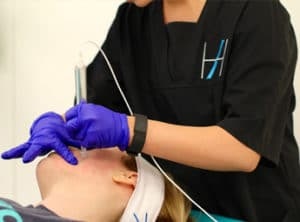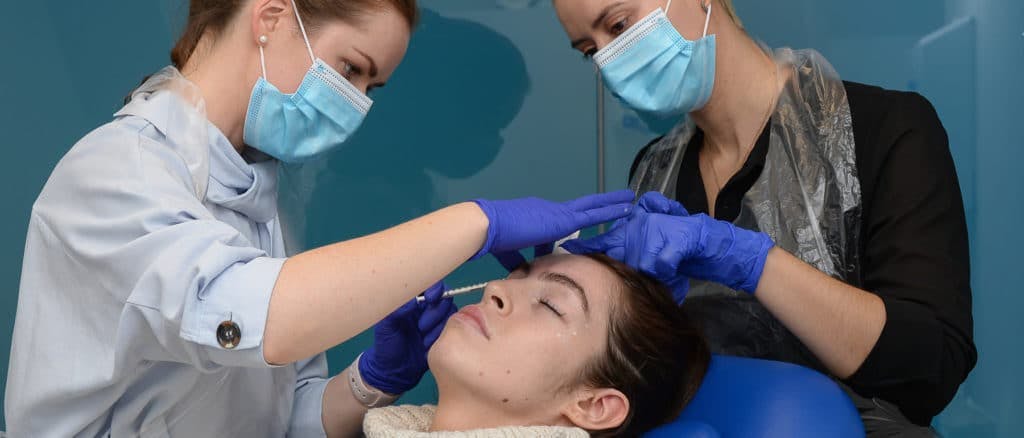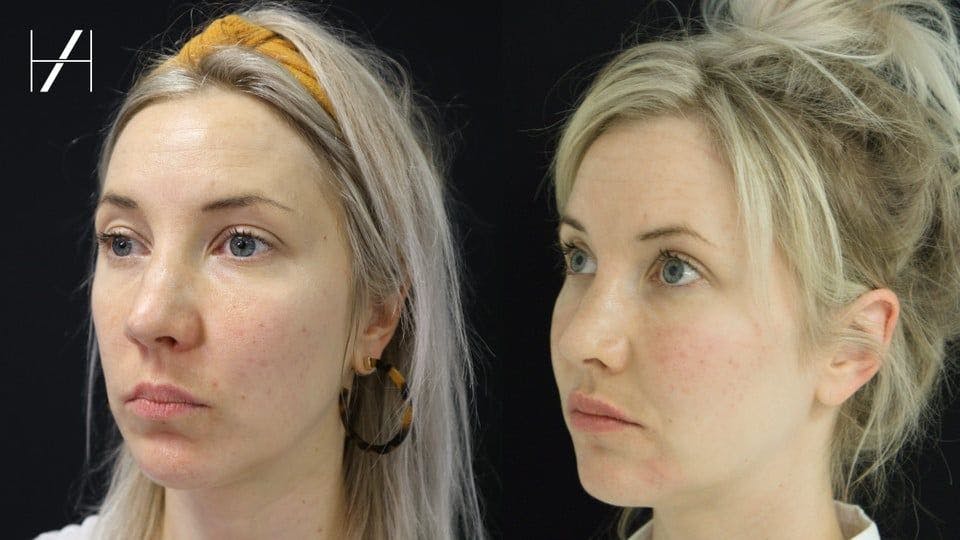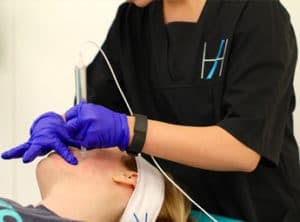The Aesthetics Treatments In Demand After Lockdown

As the UK is in lockdown once again, it’s time for aesthetics practitioners to look forward and prepare. But how to know what to prepare for, exactly?
We have all been hearing about the boom our industry is expecting once we can safely practice again. In order to be ready for it, ideally, we need to know which aesthetics treatments will be in demand after lockdown.
Here we predict some of the most requested tweakments for 2021 and explore the wider consumer skincare trends behind them.
Botulinum toxin (botox)

The anecdotal rise in new botox patients after the first lockdown was widely reported in the media. We definitely saw an increase at The Academy Clinic, too. These stories stated people were seeking injectables after being unhappy with their appearance on video calls. This phenomenon is what became known as “Zoom Face”.
It is also safe to assume that stressful times correlate to an uptick in wrinkle reduction treatments.
This double-trouble pairing of anti-ageing concerns and 2020 stress means botox will likely enjoy further popularity throughout 2021.
Additional opportunities may arise for botox injectors as new ways of employing the toxin are being developed. One of these involves a grid of diluted micro-botox injections from forehead to jaw, rather than the traditional site-specific wrinkle-relaxing doses.
Natural-looking fillers
Dermal fillers have been growing in popularity despite media coverage of various overdone celebrity looks dubbed ‘pillow face’. This has, in fact, led to a backlash against ‘obvious’ and ‘puffy’ results caused by using too much or poorly administered filler. Whether for the face or lips, 2021 is all about keeping fillers natural-looking.
British Vogue’s 8 Most Interesting Skincare Trends for 2021 list declared readers should “Ready yourself for a year of injectables”. It heralds a rise in all types of injectable treatments, advocating for “subtle tweaks, focusing on the quality of skin, naturally shaped lips, baby Botox and a nod to (rather than erasure of) our unique facial quirks.”
Discerning use of temple filler also received a special mention. As The Aesthetics Show viewers will know, this is a favourite treatment of Harley Academy founder and CEO, Dr Tristan Mehta. Continues below…

Before (left) and After: An example of the type of natural-looking results that can be achieved with specialist use of filler
Advise your patients honestly about how much filler they should be getting. Our 1:1 injectables training courses are great for increasing confidence in this area, honing your skills in dealing with patients, as well as your technique as an injector.
If you believe they require slightly less volume than they request, discuss starting with the smaller dose, then potentially topping up. However, if a patient is intent on having an exaggerated look, think carefully about whether you should treat them.
This is both an ethical dilemma and a business decision. Each patient is a walking billboard for your work and your business – what image do you want to portray to potential clients?
Microneedling and facial filler for acne scarring

Patients are becoming more educated as to the benefits of facial filler for acne scarring, thanks to a number of reputable magazine articles on the subject.
Bellafill is currently the only dermal filler to be FDA approved specifically for acne scar treatment. As this is made from bovine collagen and polymethylmethacrylate (PMMA), allergy testing of patients is required as the cow-derived ingredients may cause adverse reactions.
Juvederm and Restylane fillers are also commonly used for treating atrophic or hypertrophic acne scars. Both are hyaluronic acid-based formulas that are suitable for all skin types.
Not everyone who enquires about injectables for acne scars will be suitable, of course.
Microneedling is a great cosmetic dermatology skill for injectors to learn as it can be performed alone or paired with other treatments. By stimulating the skin’s natural collagen production and healing mechanisms, it offers a number of benefits. These include fading acne scars over a course of treatment.
As acne is a perennial skin issue, treating this may provide add-on benefits for aesthetics practitioners who also sell skincare.
Conducting a skin assessment, consultation and making recommendations, including putting together a skincare routine, can all happen online during lockdown. That way, you start to build a relationship with your patient and their skin should be looking its best by the time you see them in person.
Don’t be afraid to charge for this advice – you can always make the fee redeemable against their next purchase to encourage repeat business.
High-precision fillers
We have seen interest in tear trough filler and injectable rhinoplasty ramp up over the past couple of years. These are high-precision fillers which require a specialist hand.
Tear trough filler is used to address volume loss in the under-eye area.
Non-surgical nose jobs involve injecting hyaluronic acid-based filler to shape the nose.
Training courses for these are being developed for 2021. They require experience, confidence and extreme precision to obtain good results. We recommend injectors become extremely confident with their injecting skills and technique before moving on to learning these types of procedures.
For patients seeking tear trough fillers, consider whether a temple treatment may suit them instead. This is something successful Level 7 graduates will be able to offer and may provide the “lift” to the tear trough your patient is looking for, without actually treating the area itself.
‘Glowing skin’ treatments
Sales of beauty products soared in 2020 – especially online – leading to British Vogue christening it “the indisputable year of skincare”.
Whilst injectables are reportedly set to soar, skincare product sales are predicted to slow in 2021. Consumer research published in Cosmetics Business advises we’ll see glowing skin – with fewer, more targeted products – taking priority over makeup.
Patients want to optimise their natural skin texture, promoting radiance so their skin looks good without makeup. This trend, known as “skinimalism”, provides various opportunities for aesthetics professionals.
New skin boosters, such as Restylane Skinboosters and Luminera’s Hydral, with their ability to create a “glowing” complexion as well as restoring volume and elasticity to the skin, can meet this patient demand.
Chemical peels offer visibly brighter skin whilst microneedling can even out skin tone and improve the efficacy of skincare products applied directly afterwards. Both treatments can be combined with other services and can form part of a regular skin regimen, offering an on-going stream of income to practitioners.
So what can you do now, during lockdown, to prepare yourself for the increased demand in aesthetics treatments that’s coming? Firstly, ensure you are properly trained.
Doctors, dentists or nurses considering making the switch to aesthetics, or those wanting to add new skills to their practice, should consider using this time for online courses in aesthetic medicine and cosmetic dermatology.
Build up your skills and knowledge from wherever you are, whenever you are free with comprehensive eLearning courses that fit around your schedule. You will also receive lifetime access to these educational materials, so you have a ready-made set of reference tools for whenever you need a refresher.
The second most important thing you can do to prepare is to make sure your patients know what you offer and what it can do for them! Take time to grow your social media presence and let people know about your practice. If you’re not sure where to get started, this is something our experts can guide you through in our online Business Marketing for Aesthetic Medicine course.
Once your skills are sharp and your marketing is too, you should be well on your way to aesthetics excellence… bring on the Zoom boom!
All information correct at the time of publication
Download our full prospectus
Browse all our injectables, dermal fillers and cosmetic dermatology courses in one document
By submitting this form, you agree to receive marketing about our products, events, promotions and exclusive content. Consent is not a condition of purchase, and no purchase is necessary. Message frequency varies. View our Privacy Policy and Terms & Conditions
Attend our FREE open evening
If you're not sure which course is right for you, let us help
Join us online or in-person at our free open evening to learn more
Our Partners












STAY INFORMED
Sign up to receive industry news, careers advice, special offers and information on Harley Academy courses and services

